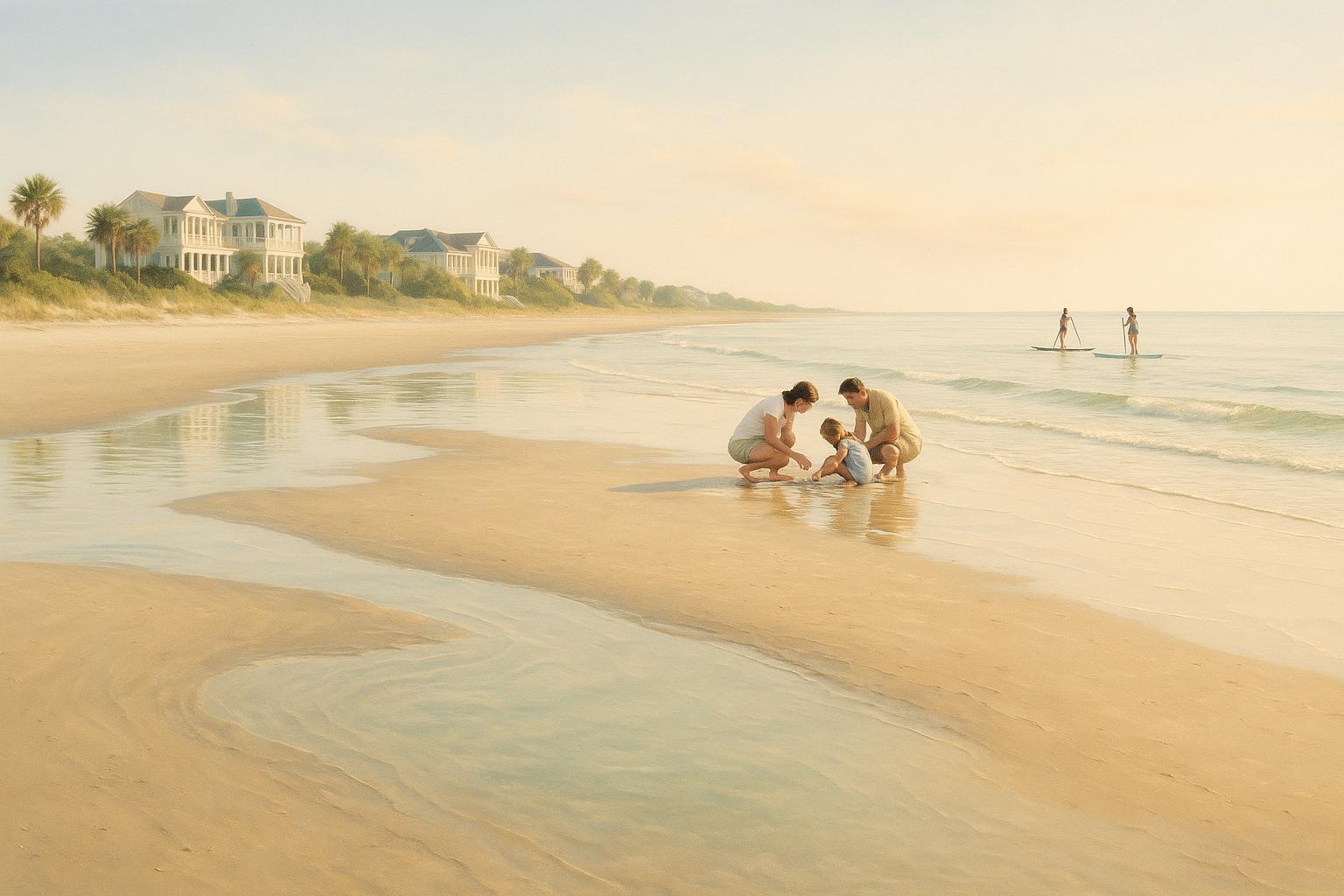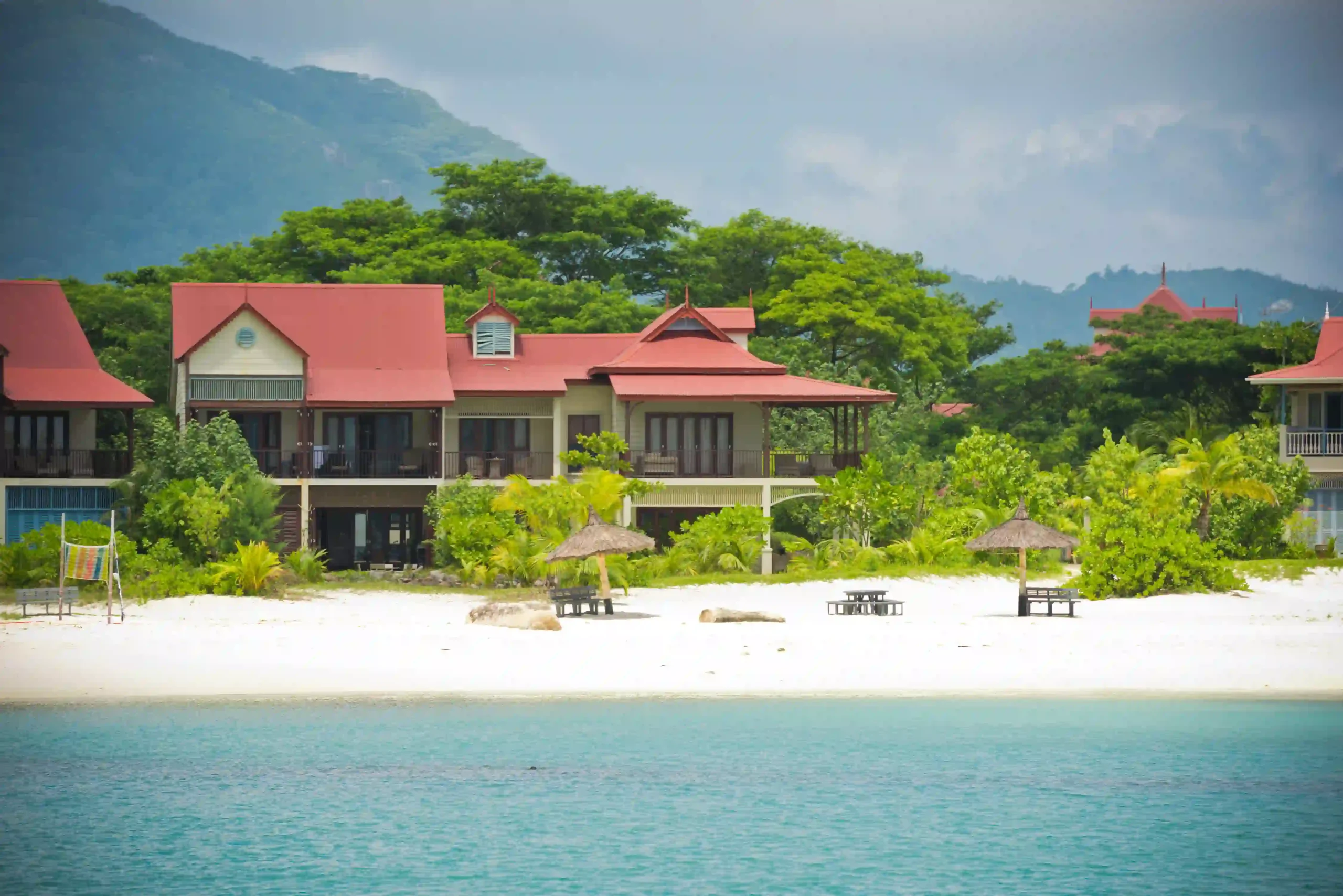Want to enjoy the beach while protecting nature? Here’s how you can make simple, impactful choices for a clean and safe coastline. From packing reusable gear to respecting wildlife, every step you take matters. Here’s a quick breakdown:
- Pack smart: Bring reusable water bottles, metal utensils, and reef-safe sunscreen to reduce waste and protect marine life.
- Reduce waste: Avoid single-use plastics, clean up after yourself, and participate in beach cleanups.
- Respect wildlife: Keep your distance, avoid feeding animals, and follow nesting area guidelines.
- Choose eco-conscious lodging: Stay at rentals like Aerie at 715 Ocean, designed with nature-friendly features.
- Plan activities wisely: Opt for paddleboarding, snorkeling, or guided wildlife tours that minimize disruption to ecosystems.
What to Pack for Your Beach Trip
Packing smartly for your beach getaway can make a big difference – not just for your experience but also for the environment. By choosing reusable and eco-conscious items, you can enjoy the beauty of the coast while helping to protect it. Here’s a guide to packing responsibly, including reusable essentials, safe skincare, and sustainable beach gear.
Reusable Items to Bring
Reusable water bottles are a must-have. Opt for stainless steel or BPA-free materials, and consider insulated versions to keep your drinks cool during those sweltering beach days. This simple choice can save you from using dozens of disposable plastic bottles.
Metal utensils and straws are a great alternative to single-use plastics. Pack a small set with a fork, knife, spoon, and a collapsible straw. Many of these sets come with handy carrying cases that fit neatly into your bag.
Cloth shopping bags and mesh produce bags are versatile and eco-friendly. Use them for everything from carrying groceries from the local farmers market to stashing wet swimsuits. Look for options made from organic cotton or recycled materials for an added environmental boost.
Glass or stainless steel food containers are perfect for snacks and meals. They’re durable, leak-proof, and don’t contribute to plastic waste. Mason jars are especially useful for drinks, salads, or even overnight oats, making them a favorite for beach-goers.
Safe Sunscreen and Skincare
Reef-safe sunscreen is essential for protecting both your skin and the ocean’s delicate ecosystems. Avoid sunscreens containing harmful chemicals like oxybenzone and octinoxate, which can bleach coral reefs. Instead, opt for mineral-based sunscreens with zinc oxide or titanium dioxide – they form a physical barrier on your skin without harming marine life.
Biodegradable soap is another smart choice, especially if you plan to rinse off at outdoor showers. Traditional soaps often contain phosphates and synthetic fragrances that can pollute coastal waters. A plant-based Castile soap is a safer, eco-friendly alternative that breaks down naturally.
Natural after-sun care can soothe your skin without the use of harsh chemicals. Products like aloe vera gel, coconut oil, or shea butter offer effective relief for sunburns and dry skin. These natural remedies are easy to pack in small containers and are much kinder to the environment than aerosol sprays.
Once you’ve got your skincare sorted, it’s time to round out your packing list with sustainable clothing and beach gear.
Clothing and Beach Gear
Quick-dry clothing made from recycled polyester or organic cotton is both practical and environmentally conscious. These fabrics dry fast, wick moisture, and reduce the need for multiple outfit changes. Look for items with built-in UPF ratings to protect your skin from the sun, cutting down on the need for extra sunscreen.
Water shoes crafted from natural rubber or recycled materials are a durable and eco-friendly choice. Unlike flimsy plastic versions, these shoes last longer and provide better traction on wet or uneven surfaces.
Reusable towels made from organic cotton or bamboo are lightweight, super absorbent, and resistant to odors and mildew. Pack a large one for lounging and a smaller one for quick dry-offs – they’re perfect for humid beach conditions.
Natural fiber beach mats woven from jute, hemp, or recycled materials are an excellent alternative to synthetic mats. They’re comfortable, easy to clean, and don’t contribute to microplastic pollution. Plus, they fold up compactly, making them easy to carry.
How to Reduce Waste at the Beach
Taking care of trash responsibly at the beach isn’t just about keeping the area tidy – it’s about protecting the delicate ecosystems that thrive along our coastlines.
Skip Single-Use Plastics
Plastic water bottles are a major source of beach pollution. Instead of buying bottled water, pack a reusable water bottle before you head out. Many beach towns offer public water fountains or refill stations – ask locals or check with visitor centers to find them.
Disposable food containers from beachside eateries quickly add to the trash problem. Bring your own reusable glass or stainless steel containers and ask restaurants to pack your food in them. Most places are happy to oblige, especially when they know you’re trying to reduce waste.
Plastic bags from shops or grocery stores are another common culprit. Use cloth bags for everything from souvenirs to wet clothes or sandy beach toys. They’re not only sturdier but also a simple way to avoid unnecessary plastic waste.
Single-use cups and cutlery from food trucks or beach bars are easy to replace. Keep a set of metal utensils and a reusable cup in your beach bag. Vendors are increasingly used to customers bringing their own gear, so don’t hesitate to ask them to use yours.
By cutting down on disposables, you’ll make your beach cleanup much easier.
Clean Up After Yourself
Always pack out what you bring to the beach, and take a moment to scan the area around you – check behind rocks, under umbrellas, and secure lightweight items that the wind might carry away.
Join impromptu cleanups by picking up litter you didn’t leave behind. Spot a plastic bottle or some stray food wrappers on your walk? Add them to your trash bag. Small actions like this protect the shoreline and keep debris out of the ocean.
Keep Wildlife Safe
Reducing waste isn’t just about aesthetics – it’s also about protecting the animals that call the beach home.
Maintain a safe distance of at least 50 feet from marine life. Getting too close can disrupt their natural behavior.
Never feed wildlife – even if it seems harmless. Human food like chips or bread can harm animals by causing poor nutrition or digestive issues. Feeding them also makes them dependent on humans, which can lead to long-term problems.
Respect nesting areas during turtle and bird nesting seasons, typically from May to October along many U.S. coastlines. Avoid roped-off sections and refrain from using bright lights or camera flashes near nests, especially in the evening, as these can confuse or disturb animals.
Dispose of fishing gear responsibly if you’re fishing on the beach. Abandoned lines and hooks can injure seabirds, turtles, and other marine life. Look for fishing line recycling bins or bring used gear home to recycle at participating tackle shops.
Beach Activities That Protect Nature
Experience the natural charm of Isle of Palms while engaging in activities that respect and preserve the environment.
Water Sports and Ocean Fun
Paddleboarding and kayaking are fantastic ways to explore the coastline and observe marine life up close. Their quiet nature makes them perfect for spotting wildlife without causing disruption.
If you’re surfing, stick to designated areas and be mindful of delicate coastal habitats. Local surf schools can provide tips on ocean safety and respectful practices to ensure you enjoy the waves responsibly.
Snorkeling in shallow waters offers a glimpse into the underwater world without the need for bulky equipment. While marveling at marine life, avoid touching or removing anything from its natural environment.
Also, opt for reef-safe sunscreen when swimming. It not only protects your skin but also helps safeguard the marine ecosystem.
Wildlife and Nature Tours
For a deeper connection with the local environment, consider joining a guided wildlife or nature tour. These tours provide an educational experience while ensuring minimal disturbance to the ecosystem.
Dolphin tours are a popular choice and follow strict protocols to avoid disrupting these magnificent creatures.
Bird watching at dawn is a peaceful way to spot a variety of coastal species when activity levels are low.
Sea turtle nesting tours offer a unique opportunity to learn about conservation efforts. These programs are carefully designed to respect nesting guidelines and support protection initiatives.
If photography is your passion, nature photography can be a rewarding way to capture memories. A telephoto lens allows you to take stunning shots while keeping a safe distance from wildlife.
Before booking any wildlife tour, research the operator’s dedication to conservation. Responsible companies will educate participants about local ecosystems, adhere to wildlife protection guidelines, and actively contribute to conservation efforts.
Beach Games and Relaxation
After a day of adventure, take time to relax with beach activities that are both enjoyable and eco-friendly.
Start your day with beach yoga at sunrise or wind down at sunset. A reusable yoga mat or towel and choosing locations away from sensitive wildlife areas ensure a peaceful experience that doesn’t harm the environment.
If you’re in the mood for games, opt for sustainable equipment when playing frisbee or volleyball, and always be cautious near dunes and vegetation.
For quieter moments, relax under a reusable beach umbrella or pop-up tent instead of disposable options. Bring along a reusable water bottle and pack meals in reusable containers to cut down on waste while enjoying your time by the shore.
When beachcombing, collect only empty shells or driftwood, leaving the natural environment as it is.
Being mindful of how your actions impact local communities, wildlife, and ecosystems is essential. Simple steps, like scheduling activities around wildlife habits and using eco-friendly products, help preserve the beauty of Isle of Palms for generations to come.
sbb-itb-af832cd
Where to Stay for Your Beach Trip
Choosing the right place to stay is just as important as planning your activities when it comes to minimizing your impact on the environment. Aerie at 715 Ocean, a top-tier vacation rental on Isle of Palms, offers the perfect mix of luxury and eco-conscious living, all while being steps away from the beach. This property makes it easy to enjoy a responsible and relaxing coastal getaway.
Eco-Conscious Living at Aerie at 715 Ocean

This vacation rental is thoughtfully designed with environmentally friendly features. It boasts spacious living areas, a gourmet kitchen, private bedrooms, and inviting outdoor spaces. Plus, shared accommodations help reduce the overall travel footprint, making it a smart choice for eco-minded travelers.
Explore Nature Nearby
Staying at Aerie at 715 Ocean means you’re perfectly positioned to embrace the outdoors with minimal travel. Its sustainable design pairs seamlessly with local eco-tourism activities. For added convenience, the property offers golf cart parking and rentals upon request, providing an easy and environmentally friendly way to explore Isle of Palms and nearby natural attractions.
Plan Your Stay
To ensure you secure your dates, it’s a good idea to book early. Opting for eco-friendly accommodations like Aerie at 715 Ocean is a meaningful step toward planning a responsible beach vacation. With room for up to 16 guests, it’s an ideal choice for group trips. Arrive using environmentally friendly transportation, and enjoy a stay that blends coastal luxury with a commitment to sustainability.
Planning Your Perfect Beach Trip
Creating a beach getaway that’s kind to the environment starts with smart planning. The choices you make before heading out can shape not just your vacation, but also the health of the coastal areas you visit.
Start by choosing the right time to go. For instance, visiting Isle of Palms in late spring or early fall offers quieter beaches, less strain on the local environment, and often better opportunities to spot wildlife. With temperatures in the comfortable range of 70°F to 80°F, you’ll also avoid the intense summer heat and the heavy impact peak tourism can have on fragile ecosystems.
Your transportation decisions play a big role in keeping your trip eco-friendly. If you’re traveling with a group, carpooling can cut down on emissions. If flying is necessary, opt for direct flights to reduce your carbon footprint. Once you’re there, rely on walking or biking for short distances, or rent a golf cart – an energy-efficient alternative to traditional cars – to explore the island.
When it comes to where you’ll stay, look for accommodations that combine comfort with eco-conscious practices. Traveling with a group can naturally lower the environmental impact per person, and choosing a rental with a fully equipped kitchen allows you to prepare your own meals. This not only cuts down on takeout packaging but also gives you the chance to shop at local farmers’ markets, supporting the community while enjoying fresh, regional produce.
Once your travel and lodging plans are set, make sure your activities align with local guidelines. Familiarize yourself with regulations, such as those protecting wildlife or managing waste disposal. For example, Isle of Palms enforces sea turtle nesting season restrictions from May through October. Knowing these rules helps you plan activities that respect the environment and safeguard local species.
Packing smart is another way to reduce your impact. Bring only what you truly need, and think about the eco-footprint of each item. Many vacation rentals provide essentials like kitchen supplies and entertainment options, so you can pack lighter. This not only makes travel easier but also reduces transportation emissions. Using smartphone apps for tide charts, weather updates, and itineraries is another great way to avoid unnecessary paper waste.
FAQs
What are some eco-friendly beach essentials to help protect the environment?
Choosing eco-friendly beach gear is a smart way to enjoy the outdoors while being kinder to the planet. Start with mineral-based, non-toxic sunscreen – it’s safer for marine life compared to chemical-based alternatives. Pair it with UV-protective clothing made from sustainable fabrics to cut down on waste.
Stay hydrated with a reusable stainless steel water bottle, which eliminates the need for single-use plastics. For kids (or your inner child), pick silicone or recycled plastic beach toys – they’re durable and have a smaller environmental footprint. When it comes to larger items like umbrellas or chairs, opt for ones made from natural or recycled materials. These thoughtful choices help keep beaches cleaner and protect delicate ecosystems.
What should I look for in a sunscreen to ensure it’s safe for marine life?
To help safeguard marine ecosystems, choose mineral-based sunscreens containing zinc oxide or titanium dioxide in their non-nano form. These ingredients are much gentler on coral reefs and aquatic life.
Steer clear of chemical components like oxybenzone, octinoxate, octocrylene, homosalate, and parabens, as they can damage coral reefs and negatively impact marine habitats. Taking the time to read labels and selecting reef-safe options can play a meaningful role in protecting ocean health.
How can I reduce my environmental impact while enjoying a beach trip to Isle of Palms?
Heading to Isle of Palms for a beach trip? There are plenty of small choices you can make to help protect the local environment while enjoying your getaway. For starters, consider leaving the car behind when exploring nearby spots – walking, biking, or even using a golf cart are great alternatives that reduce your carbon footprint.
When booking your stay, look for accommodations that prioritize eco-friendly practices. While you’re there, why not get involved in activities that give back to the area? Joining a beach cleanup or contributing to wildlife preservation efforts are meaningful ways to support the local ecosystem.
You can also cut down on waste by packing reusable essentials like water bottles, utensils, and shopping bags. Conserve resources by being mindful of your water and electricity usage, and always stick to local guidelines designed to protect wildlife and natural habitats. These small, thoughtful actions can add up to create a positive impact!




